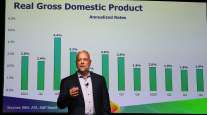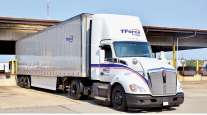Senior Reporter
Truck Orders to Plunge, GDP to Fall Lower, Diesel Prices to Rise in 2020

[Stay on top of transportation news: Get TTNews in your inbox.]
As 2020 begins, the signs are mixed for trucking. Expectations for an environment marked by weaker freight demand, pressure on profitability, higher-priced diesel and falling truck and trailer production mix with lingering talk in some circles of a possible recession. An uncertain national political environment could also chill business outlooks.
At the same time, hopeful signs are appearing — U.S.-China tariffs appear to be getting sorted out and a new trade agreement vital to trucking is on tap. And despite the nearer-term outlook, equipment suppliers continue to invest for better times.
While Canadian approval yet remains, Mexico’s parliament has approved the pending U.S.-Mexico-Canada Agreement on trade that replaces NAFTA. The U.S. House approved the measure Dec. 19, and it looks like the Senate will vote on it in early 2020.
In our 2020 Freight Focus, we analyze the ups and downs of the past year to get a clearer view on the year ahead. Plus, our Data Science team shares where rates are heading in 2020. https://t.co/yU4ygi4dLr pic.twitter.com/TBIXwOHdfC — DAT Solutions (@LoadBoards) November 18, 2019
“By the nature of our work, truckers know the significance of this victory,” American Trucking Associations President Chris Spear wrote in an op-ed. “Cross-border trade with our neighbors has become a cornerstone of the American economy. There were more than 12 million truck crossings along our Canadian and Mexican borders in 2018 alone, hauling more than $772 billion worth of goods.”
At the same time, DAT Solutions, which operates a load board, forecast truck availability to be more constrained in 2020 compared with 2019, and anticipates a rebound in spot market rates — with van rates up 4% to 6% in the second half of 2020. Contract rates should climb about 2%.
“Of course, a number of factors could change that trajectory. For starters, 2020 is a presidential election year, which adds an extra layer of uncertainty,” DAT wrote in its 2020 Freight Forecast.
ATA Chief Economist Bob Costello noted that while the spot market is a relatively small segment of the trucking industry, any decline is hard on companies that rely heavily on that business.
“Those fleets that play primarily in that sandbox, they’ve got to be hurting,” Costello said. “This is where we’ll see a shakeout [in 2020]. If you take into account wages that have increased, insurance costs and what’s going on with volumes, rates, they’ve got to be hurting.”
On the flip side, Costello said he was optimistic about contract business in 2020. While there has been a decline in prices, the dip is far less than what has taken place on the spot market, he said.

Perry
One economist with a contrarian view of the overall economy is Noel Perry with the firm Transport Futures. He’s predicting a recession in 2020.
“The slowdown we have already seen, which is a fact in both manufacturing and trucking in 2019, is typical of the year before a recession. So, yes, I am specifically forecasting a recession beginning in the third quarter of 2020,” Perry said. “The global economy is slow and that has affected our exports, and it’s knocked out as much as the trade problems we have had. That’s the first half. The second half is that the business cycle that causes recessions and recoveries is tired. People who manufacture things, who invest in things, they’re slowing down.”
Another economist is waiting to see how long it is going to take to see any “significantly positive” effects from rate cuts at the Federal Reserve.
“Typically it takes six months to nine months before monetary policy, up or down, materially affects the major interest rate components of GDP,” said Bob Dieli, an economist with MacKay & Co., a research firm specializing in the aftermarket commercial vehicle parts market.
GDP indicates whether the economy is expanding by producing more goods and services, or contracting due to less output, according to the Federal Reserve Bank of St. Louis.
“GDP growth will slow a bit further [in 2020] and dip below 2%, according to the Survey of Professional Forecasters consensus. Forecasters also see a roughly 1 in 3 probability of a recession developing in 2020 or 2021, according to the Blue Chip consensus,” the St. Louis Fed noted in a report — but if headwinds lessen that could push GDP growth back above 2%.
A hallmark of the current expansion [underway since July 2009] in the U.S. economy is its relative lack of large and noticeable imbalances, according to analysts at Wells Fargo. “Consequently, our base-case scenario calls for the U.S. economy to continue to expand. That said, the 2% or so GDP growth rates that we forecast for next year and 2021 are hardly robust.”
Meanwhile, if it seems the situation regarding the ongoing trade war between the U.S. and China is getting a bit more certain, that’s because it is; the two countries late last year reached consensus on a phase one trade agreement that stopped a new round of damaging tariffs from being imposed on products from both nations.
The pending deal commits China to purchase $50 billion in American agricultural products over the next two years, and includes key “structural changes” regarding China’s handling of intellectual property, technology and financial services. In return, new tariffs scheduled for Dec. 15 were postponed.
In related news, on Jan. 1, a new International Maritime Organization rule went into effect that requires global shipping companies to cut the sulfur emissions from ocean vessels dramatically, either by cleaning up or replacing “bunker fuel” — the sulfur-rich residue left over once refineries have made gasoline and diesel that ocean vessels have burned for years.
Some in trucking were worried that a switch among maritime operators to ultra low-sulfur diesel from bunker fuel would put pressure on ULSD supplies for trucking.

Leathers
Derek Leathers, CEO of truckload carrier Werner Enterprises Inc., said he believes no one in trucking knows what the outcome is going to look like.
“I’ve seen people say they think it’s a relatively nonevent. I don’t agree with that. I’ve also seen people talk about 70 cents- to $1-type spikes in diesel. I think that’s a bit overstated. I think somewhere in that goal post is where it falls out,” he said.
Whatever the change in price, the U.S. Energy Information Administration anticipates the effects on petroleum prices will be most acute in 2020, and then will be moderate after that.
It’s estimated the shipping industry may need as much as 4 million barrels a day of ULSD (or 48 million gallons a day) with a 0.5% limit on sulfur by weight compared with the 3.5% content they use now. Trucking uses about 38.8 billion of gallons a year — or 106.3 million gallons a day — of ULSD with sulfur capped at 15 parts per million.
EIA Year in Review 2019: EIA added forecasts of wholesale #electricity prices in the Lower 48 states and in-depth analysis on the new the International Maritime Organization (#IMO2020) regulations in the Short-Term Energy Outlook. https://t.co/FocTR8yAWa #EnergyPrices #STEO pic.twitter.com/gr6wdlTZyh — EIA (@EIAgov) December 25, 2019
Refineries will have to decide how to process and price both kinds of diesel.
Petroleum refineries in the United States produce about 12 gallons of ultra-low sulfur distillate fuel oil, most of which is sold as diesel fuel and in several states as heating oil, from one 42-gallon barrel of crude oil, according to the Energy Information Administration.
In the meantime, significant declines are ahead in 2020 for medium- and heavy-duty truck production and sales as a result of lower trends in net orders and backlog volumes, said Kenny Vieth, ACT Research’s president.
“Recent articles point to a growing belief that a recession is likely to be averted in 2020, so the economic ‘days’ are likely to become brighter as we move through 2020,” Vieth said. “Unfortunately for the industry, the expected rebound will not come soon enough, or be robust enough, to take a sharp equipment downturn off the table.”
ACT has forecast North American Class 8 production to plunge, compared with 2019, by more than 100,000 units to 224,000 — or below the typical North American replacement level.
Three components are driving a cut to heavy commercial vehicle forecasts in the coming two years: demand, supply, and timing. #Transportation #HeavyDuty #Economics #Trucking #freight #logistics https://t.co/rrbEf5yGwG pic.twitter.com/GVYKBrqXCf — ACT Research (@actresearch) December 27, 2019
If GDP growth is near 2% “freight demand and shipping capacity are pretty balanced, reducing the need to expand fleets,” said Troy Clarke, chairman and CEO of Navistar International Corp. Navistar makes the International truck brand.
Industry Class 8 orders in much of 2019 ran below replacement level, but “orders will pick up and recover in the second half of the year,” Clarke said in a recent earnings call.
Trailer makers ended 2019 with a steep drop in orders, which sets up a much softer backlog in 2020.
“That would mean that we are going to see some drop-offs in production rates as trailer makers attempt to stretch the existing backlog that they have,” either by reducing days in operation or line rates in 2020, said Frank Maly, ACT’s director of commercial vehicle transportation analysis. “Reducing staff is the last thing they want to do because it took them so much effort to get them on board.”
Some trailer makers, however, are continuing to add production capacity, he said. “We do hear reports of added production capacity underway in the market here in the states.”
Some say that could set the stage for rising levels of unsold trailers in 2020, and possible price wars to clear inventory.
Truck makers, also, are looking to add to production in 2020.
Next year, Navistar will expand its Huntsville, Ala., engine facility and proceed with a new truck assembly plant in San Antonio.
Paccar Inc. is adding machining and assembly equipment in Columbus, Miss., to expand engine production of its MX-13 and MX-11 engines to be installed in its Kenworth Truck Co. and Peterbilt Motors Co. trucks.
Commercial vehicle supplier Hendrickson is adding a sixth trailer suspension plant scheduled to be completed in the first quarter of 2020. It will be located in Ohio.
Hendrickson CEO Gary Gerstenslager noted that with long-term outlooks remaining positive for freight, it’s important for companies to be ready when things eventually ramp back up. “If you want to maintain the market share you have, you have to build that facility. And that’s the long-term view we have.”
Moves toward commercializing autonomous vehicles, and using electrification and hydrogen as fuel are expected to expand in 2020, too.
“I think you are going to hear some more news not just from TuSimple but the whole industry,” said Robert Brown, head of government relations at TuSimple, which is developing self-driving truck technology. “I think you are going to see more startups, more truck makers focus on it. It is exciting.”
He said the number of companies doing truck automation is in the “high teens, which is really cool. Obviously, it is more competition for us so we just need to keep going, and the rising tide lifts all boats.”
Tesla’s all-electric Semi truck, unveiled in 2017, is expected to go into limited production at the end of 2020, according to reports. The Semi is priced starting at $150,000 for the 300-mile model and $180,000 for the 500-mile model.
Nikola has developed the most energy dense, safe battery in the world and cycled it over 2,000 times. It would double the range of every electric vehicle and nearly double the range of every fuel cell. Making it available even to competitors. https://t.co/ulKCJxiFzJ — Trevor Milton (@nikolatrevor) November 19, 2019
Nikola Corp. announced it has battery technology that would double the range of its emerging heavy-duty trucks that are either fully electric or use a hydrogen fuel cell — and will provide more details and show the batteries charging and discharging at an upcoming event in fall 2020.
Traditional truck makers also head into 2020 working to prepare for the commercial launch of electric-powered models sooner rather than later.
Want more news? Listen to today's daily briefing:




